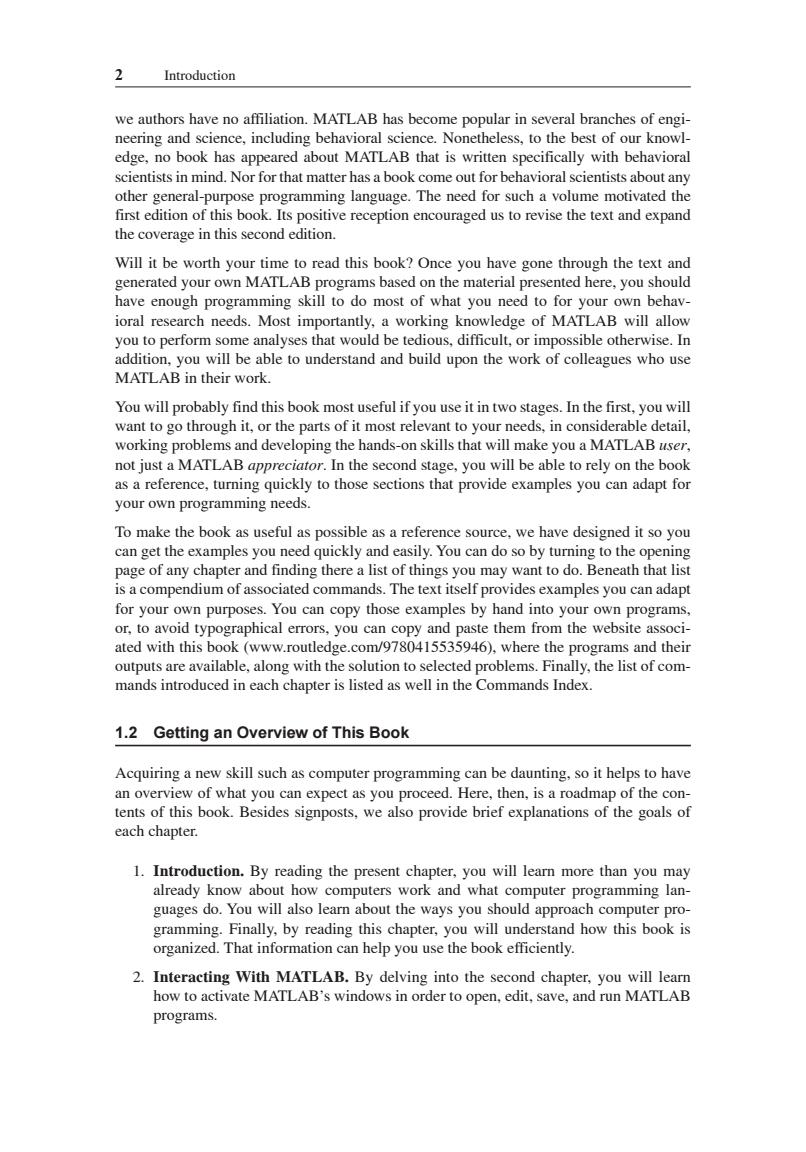正在加载图片...

2 Introduction we authors have no affiliation.MATLAB has become popular in several branches of engi neering and science,including behavioral science.Nonetheless,to the best of our knowl edge,no book has appeared about MATLAB that is written specifically with behavioral scientists in mind.Nor for that matter has a book come out for behavioral scientists about any other general-purpose programming language.The need for such a volume motivated the first edition of this book.Its positive reception encouraged us to revise the text and expand the coverage in this second edition. Will it be worth your time to read this book?Once you have gone through the text and generated your own have enough progr you need ora ing k some alyderstand and build upn thewo o MATLAB their ork leagues who use You will probably find this book most useful if you Luse it in t s.In the first ou will through it o th int to able detail and deve ng the hands-on skills that will make you a MATLAB use not just a MATLAB a In the second stag as a refer ce,rnin quickly to those secti ons that t your own programming needs. To make the book as useful as possible as a reference source.we have designed it so you can get the examples you need quickly and easily.You can do so by turning to the opening page of any chapter and finding there a list of things you may want to do.Beneath that list is a compendium of associated commands.The text itself provides examples you can adapt for your own purposes.You can copy those examples by hand into your own programs. or,to avoid typographical errors,you can copy and paste them from the website associ- ated with this book(www.routledge.com/9780415535946).where the programs and their outputs are available,along with the solution to selected problems.Finally,the list of com- mands introduced in each chapter is listed as well in the Commands Index. 1.2 Getting an Overview of This Book Acquiring a new skill such as computer programming can be daunting.so it helps to have an overview of what you can expect as you proceed.Here,then.is a roadmap of the con- tents of this book.Besides signposts,we also provide brief explanations of the goals of each chapter. 1.Introduction.By reading the present chapter.you will lear more than you may ou w how to activate MATL L.Save.a program 2 Introduction we authors have no affiliation. MATLAB has become popular in several branches of engineering and science, including behavioral science. Nonetheless, to the best of our knowledge, no book has appeared about MATLAB that is written specifically with behavioral scientists in mind. Nor for that matter has a book come out for behavioral scientists about any other general-purpose programming language. The need for such a volume motivated the first edition of this book. Its positive reception encouraged us to revise the text and expand the coverage in this second edition. Will it be worth your time to read this book? Once you have gone through the text and generated your own MATLAB programs based on the material presented here, you should have enough programming skill to do most of what you need to for your own behavioral research needs. Most importantly, a working knowledge of MATLAB will allow you to perform some analyses that would be tedious, difficult, or impossible otherwise. In addition, you will be able to understand and build upon the work of colleagues who use MATLAB in their work. You will probably find this book most useful if you use it in two stages. In the first, you will want to go through it, or the parts of it most relevant to your needs, in considerable detail, working problems and developing the hands-on skills that will make you a MATLAB user , not just a MATLAB appreciator . In the second stage, you will be able to rely on the book as a reference, turning quickly to those sections that provide examples you can adapt for your own programming needs. To make the book as useful as possible as a reference source, we have designed it so you can get the examples you need quickly and easily. You can do so by turning to the opening page of any chapter and finding there a list of things you may want to do. Beneath that list is a compendium of associated commands. The text itself provides examples you can adapt for your own purposes. You can copy those examples by hand into your own programs, or, to avoid typographical errors, you can copy and paste them from the website associated with this book ( www.routledge.com/9780415535946 ), where the programs and their outputs are available, along with the solution to selected problems. Finally, the list of commands introduced in each chapter is listed as well in the Commands Index. 1.2 Getting an Overview of This Book Acquiring a new skill such as computer programming can be daunting, so it helps to have an overview of what you can expect as you proceed. Here, then, is a roadmap of the contents of this book. Besides signposts, we also provide brief explanations of the goals of each chapter. 1. Introduction. By reading the present chapter, you will learn more than you may already know about how computers work and what computer programming languages do. You will also learn about the ways you should approach computer programming. Finally, by reading this chapter, you will understand how this book is organized. That information can help you use the book efficiently. 2. Interacting With MATLAB. By delving into the second chapter, you will learn how to activate MATLABÊs windows in order to open, edit, save, and run MATLAB programs